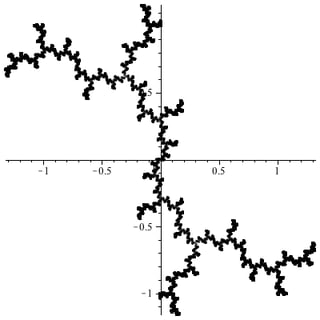The Julia set of the map $z \mapsto z^2+i$ is a dendrite fractal. I would like to know which affine maps (other than identity) map this region to a subset of itself. I imagine there are two three generators, but maybe there are more. Perhaps I am after an "iterated function system" which will generate the dendrite fractal (possibly as the limit of trees).
-
$\begingroup$ Some comments: 1. I'm fairly sure there are no such affine maps, although proving it rigorously could be hard. Proving that there are no similarities might be easier using ideas of Andras Mathe and others. 2. The Julia set is invariant under the iterated function system given by the inverse branches of z^2+i, which are of course non linear. 3. Some dendrite Julia sets are conjugated to self-similar (i.e. linear) dendrites. Eroglu, Rohde and Solomyak proved that in some cases the conjugacy is quasi-symmetric. Maybe you can clarify what you need to know and what is the motivation? $\endgroup$– Pablo ShmerkinCommented Aug 22, 2011 at 4:42
-
$\begingroup$ I'm quite sure $z\mapsto -z$ is such an affine map. $\endgroup$– user5810Commented Aug 22, 2011 at 4:46
-
1$\begingroup$ Some fractals arise as limit sets of "iterated function systems" of affine maps (like the Gosper snowflake). In this case, the maps are non-linear. My mistake. $\endgroup$– john mangualCommented Aug 22, 2011 at 6:09
-
2$\begingroup$ The maps here are not affine. But they are conformal. The set can be divided into a finite number of parts (maybe 2 or 4), so that each part is the image of 2 of the parts under a conformal map. In fact, the conformal maps are branches of the inverse of $z^2+i$, namely $\pm \sqrt{w-i}$. A student of mine, Jeff Golds, worked out some cases, but for certain Julia sets that are homeomorphically circles. $\endgroup$– Gerald EdgarCommented Aug 22, 2011 at 18:37
-
1$\begingroup$ Gerald, are you talking about section 4 of math.osu.edu/~edgar/preprints/golds/edgar992.pdf? And is there further work? $\endgroup$– Tom LeinsterCommented Aug 22, 2011 at 20:02
2 Answers
What you are after is really the combinatorics of the branched cover $z\mapsto z^2+i$ on the Julia set $J$. Namely, you really want to consider $J$ as a dynamical system, and not just as a topological space.
As mentioned above, the map $z\mapsto z^2+i$ is not linear, but you could approximate it by something piecewise linear if you want: you would then get an equivalent dynamical system on the corresponding Julia set.
As a mere topological space, the set of homeomorphisms of $J$ is HUGE.
The space $J$ is actually uniquely characterized up to homeomorphism by the following properties:
- it is compact metrizable.
- it is one dimensional.
- it is locally connected and simply connected.
- all its points have valence 1, 2, or 3
(here, the valence is the number of connected components that you get after removing the point) - the set of points of valence 3 is dense.
This is a little bit similar to the characterization of the Cantor set as the unique compact metrizable zero-dimensional space with no isolated points.
So you see that you have a lot of freedom, and that you can represent many, many dynamical systems on that same topological space $J$.
-
$\begingroup$ André, can you give us a reference for this unique characterization of J? Thanks. $\endgroup$ Commented Aug 22, 2011 at 16:03
-
$\begingroup$ No. I just made it up. But I also have a kind-of-vague-argument in my head that proves that any two spaces with those properties are indeed homeomorphic. $\endgroup$ Commented Aug 22, 2011 at 16:19
-
2$\begingroup$ OK! Well, if you ever see an argument like this in print, or write one yourself, I'd be interested to hear about it. (I know the characterization of the Cantor set that you mention, but this is more sophisticated.) $\endgroup$ Commented Aug 22, 2011 at 16:26
-
$\begingroup$ I forgot to impose a local connectivity condition... $\endgroup$ Commented Aug 22, 2011 at 16:51
-
$\begingroup$ $J$ has the topological type of a compact $\mathbb{R}$-tree whose singular points have valence 3 or 1, such that the valence 3 points form a countably infinite dense subset. Given two such spaces, one can construct a homeomorphism by specifying a correspondence on the countable sets of valence 3 points, and such a correspondence can be chosen recursively using the geodesic structure. $\endgroup$– S. Carnahan ♦Commented Aug 23, 2011 at 3:58
OK, as hinted in my comment. Here is the fractal $J$:

Now choose a branch of the squareroot so that $\sqrt{w-i}$ is continuous on this set. Here is the image of $J$ under the map $\sqrt{w-i}$ in green, and the image of $J$ under the map $-\sqrt{w-i}$ in red:

Thus $J$ is the attractor of a certain IFS (but not using affine maps).
-
$\begingroup$ The set could be called self-conformal not self-similar. $\endgroup$ Commented Aug 23, 2011 at 12:33
-
$\begingroup$ Some examples of this kind were studied in: Barnsley, M. F.; Demko, S. Iterated function systems and the global construction of fractals. Proc. Roy. Soc. London Ser. A 399 (1985), no. 1817, 243–275 $\endgroup$ Commented Aug 23, 2011 at 20:17

